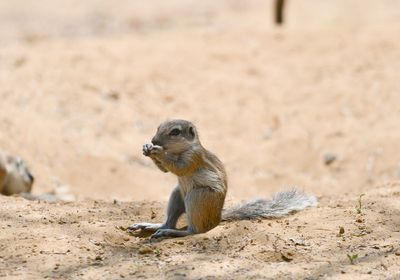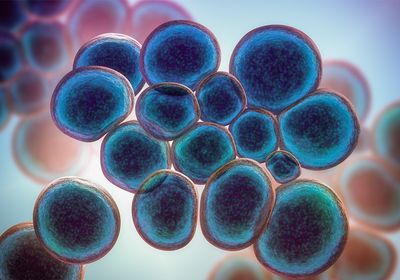ABOVE: Cape ground squirrels (Xerus inauris) already have large feet, but they may be growing to help the mammals dissipate heat as the climate warms. JANE WATERMAN
At the South African nature preserve where Miya Warrington and colleagues study Cape ground squirrels (Xerus inauris), the maximum daily temperature has increased by about 2.5 °C in just 18 years. The animals have evolved a quiver of tactics to tolerate the region’s sweltering heat, says Warrington, a conservation ecologist at the University of Manitoba. Sprawling flat on the ground in a pose called splooting, for example, helps the animals shed heat from their less furry undersides. The squirrels also take shady respites under their bushy tails, which they curl above their heads like tiny parasols. When it’s really hot, the fossorial mammals retreat to their burrows to cool off. But Warrington warns that, even with all these options for keeping cool, “still they could be at the limits of their tolerance” due to such a rapid climactic shift.
That intense pressure could be why their bodies have begun to change shape, Warrington says. She found that, over the course of just under two decades, the squirrels’ already incredibly large hind feet, which may help dissipate heat, have grown relative to their body sizes by about 11 percent. Meanwhile, their spine lengths have become about 6 percent shorter.
And the Cape ground squirrel isn’t the only animal that appears to be shape-shifting in response to climate change. As scientists accumulate more evidence that many species’ bodies are undergoing subtle changes over a relatively short period of time, it remains unclear whether their adaptations can keep ahead of spiking temperatures—and how close they may be to a breaking point.
Little bodies, big limbs
In the late 1800s, two biologists proposed separate but related hypotheses that endotherms’ bodies varied by latitude due to temperature. Bergmann’s rule posits that animals living near the warmer tropics tend to develop smaller bodies, while Allen’s rule predicts that appendages become larger across the same spatial gradient. In both cases, the two biologists (after whom the rules are named) proposed that thermal adaptations to dissipate heat governed these trends.
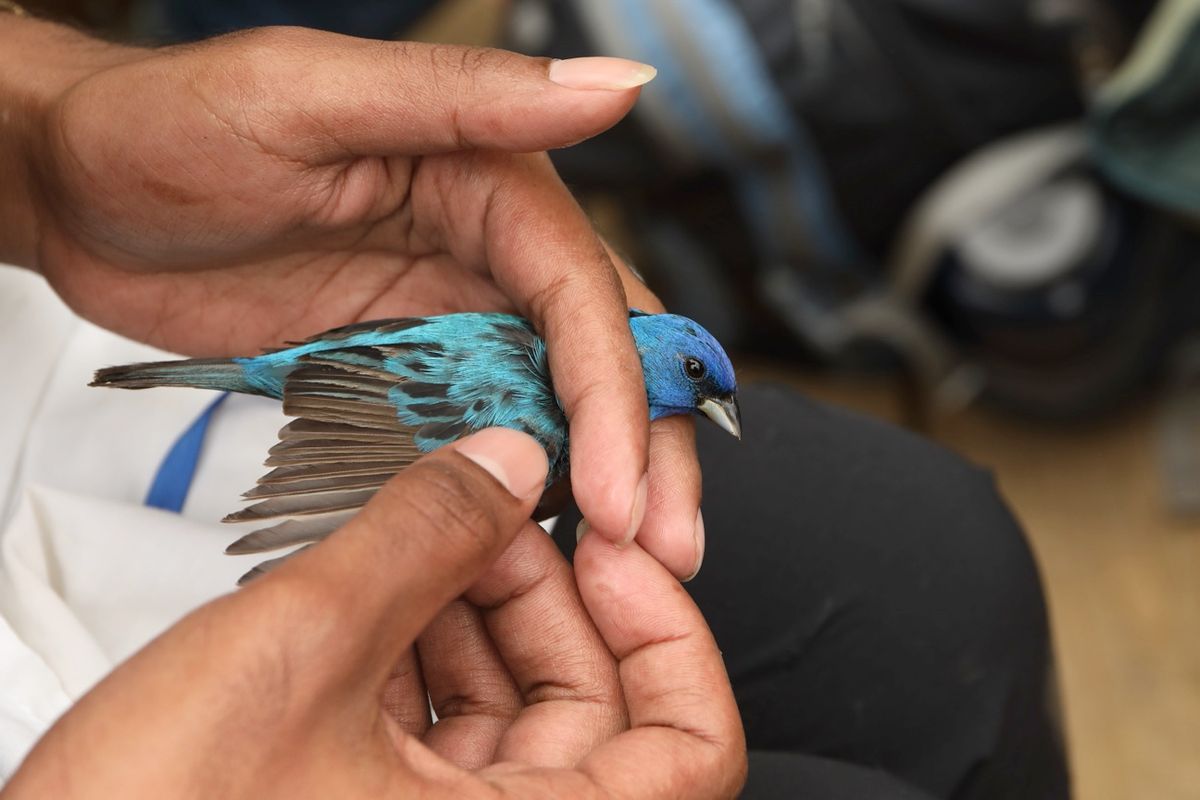
“When you’re a smaller individual, you have a larger surface area to volume ratio, which allows you to basically dissipate heat more readily,” says Casey Youngflesh, a quantitative ecologist at Michigan State University. While Bergmann’s rule considers variations in latitude, Youngflesh sought to determine whether bird body sizes shrank temporally as climate change has driven hotter weather in areas throughout North America.
Looking across 105 avian species’ entire ranges, he and his colleagues scoured bird banding data compiled by The Institute for Bird Populations and found significant body mass reductions in 80 species over three decades. The analysis included more than 250,000 birds and found that the mean decline in mass across all species was about 0.6 percent, with tree swallows (Tachycineta bicolor) registering the largest decline at about 2.8 percent.
While the absolute numbers may seem small, Youngflesh points out that most evolutionary changes span geologic timescales. “I think we have to remember that this is only a period of 30 years,” he says. “And so seeing these sorts of changes over such a rapid timescale—it’s a little shocking.”
Phred Benham, an ornithologist and evolutionary biologist who wasn’t involved in Youngflesh’s study, agrees. “The scale of [their] project is immense,” he says, adding that to record this change in so many species over such a short period “really suggests that there is something global affecting all these birds—and climate change is what makes sense.”
See “Identifying Future Victims of Climate Change”
Youngflesh’s study also finds that while absolute bird wing lengths tended to remain the same over time, they became relatively longer compared to the birds’ shrinking bodies. However, Youngflesh hypothesizes this increased “wingyness” has less to do with heat dissipation, as Allen’s rule might suggest, and more to do with seasonal migrations. “When populations tend to migrate farther, they tend to have longer wings,” he says, adding that this finding may reflect birds’ need to preserve their ability to fly long distances seasonally.
Beaks, on the other hand, do appear to change based on temperatures, says Benham, who previously studied the phenomenon. “Having a bigger surface area allows [bird bills] to dissipate more heat passively, without additional metabolic costs, and also without relying on evaporative cooling,” he says, adding that this helps them preserve water.
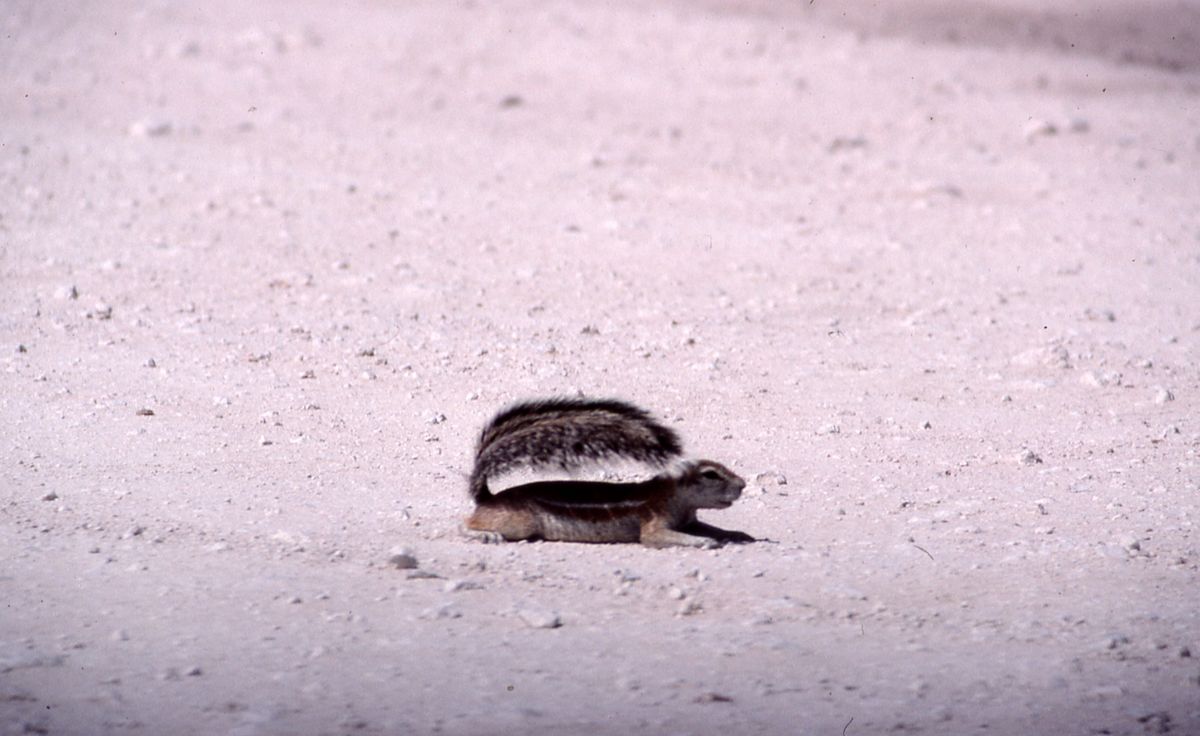
Benham evaluated four subspecies of California savannah sparrows (Passerculus sandwichensis) and found that, as Allen’s rule would predict, bill size was generally larger in populations that lived farther south in California. However, he found growing beak sizes attributable to warmer and dryer conditions associated with climate change in only the coastal subspecies, P. sandwichensis alaudinus. Populations of this subspecies that reside in high-salinity tidal marshes in the state’s interior, where there’s far less fresh water, saw their beak surface areas expand up to roughly 7 percent in 150 years.
He and his colleagues then estimated this increase in bill size could reduce daily water loss by as much as about 16 percent. “If it’s gotten hotter through time, the costs to keeping cool are probably greater in a water-limited environment,” Benham explains. Because of this hypothesis, he says it would be interesting to see whether Youngflesh’s analysis shows more pronounced body size reductions in arid locations compared to humid ones.
Pollination problems
While Bergmann and Allen’s rules imply animals evolve changes in size over millennia to withstand latitudinal temperature gradients, another rule–the temperature-size rule—describes a type of phenotypic plasticity that occurs in most ectotherms. “In almost every insect that [scientists have] looked at this, when you crank up the temperature that the juveniles develop through, the adults are always smaller in body size,” says Michelle Tseng, an insect and aquatic ecologist at the University of British Columbia. According to the theory, that’s because warmth speeds developmental biochemical reactions and shortens the time it takes an ectotherm to mature, resulting in a smaller adult, Tseng says.
But when it comes to studying the real-world implications of these changes, scientists “often don't clearly distinguish between statistical significance and biological significance,” Tseng says. Sometimes this is because they simply don’t know the real-world implications of their findings, but also because statistical significance tends to matter more when publishing. However, Tseng wanted to bridge that gap by designing an experiment that investigated whether temperature-induced shrinking might affect butterflies’ pollinating behavior.
See “Climate Change Prematurely Ages Lizards Before They’re Born”
“Those pollinator interactions are super important” for biodiversity, she says, because plants rely on pollinators to mix genes. Yet, “we don’t know very much at all about how insect body size affects . . . these plant-insect interactions.” To do that, she and her colleagues first investigated how climate change may affect the body and wing sizes of cabbage white butterflies (Pieris rapae). Tseng waited for the insects to lay eggs on the leaves of kale she grew in pots outside her home, which she would gently knock off and bring to her lab.
After the eggs hatched, Tseng and colleagues put the larvae into incubators controlled at 18 °C, 24 °C, and 30 °C. The warmest-reared insects matured about twice as fast, had the lowest body masses and smallest wing areas, and flew at slower velocities compared to the coldest-reared butterflies.
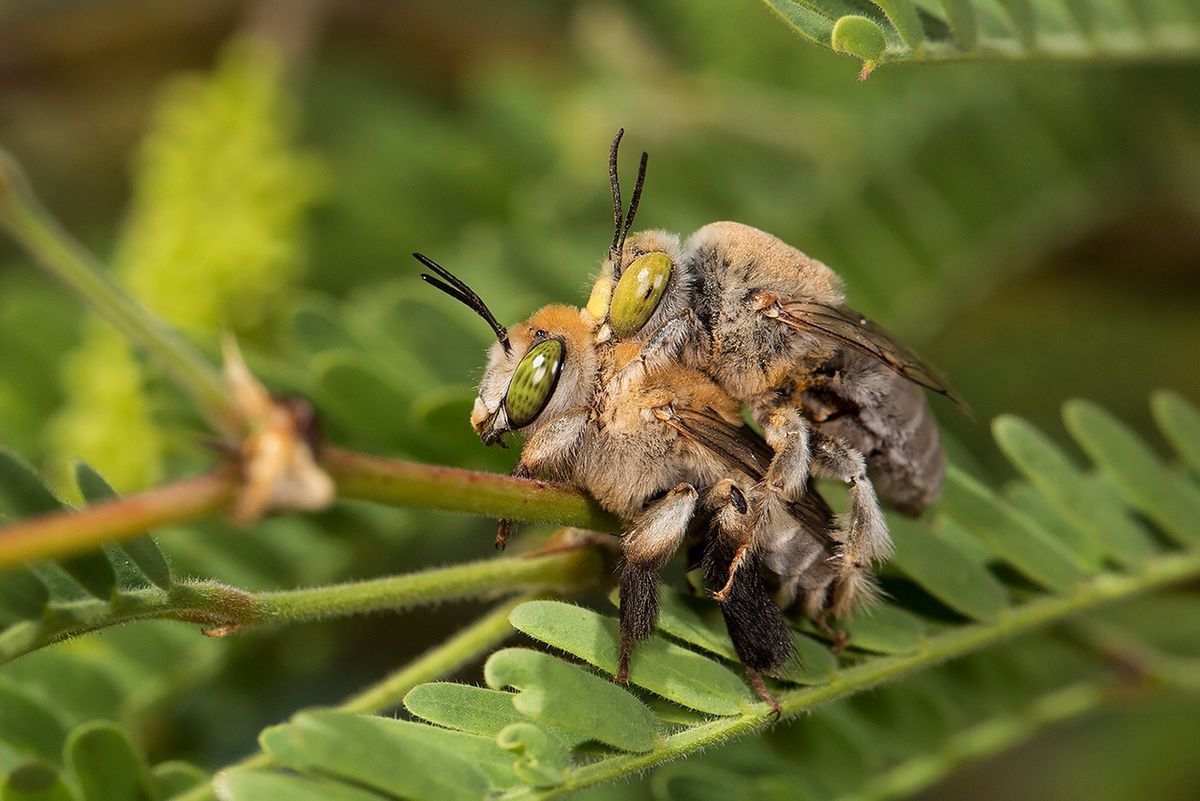
To determine whether these morphological shifts were biologically significant, she and her colleagues collected the same butterflies from the wild, sorted them into size groups that corresponded to her lab-grown specimens, and analyzed how much pollen they had accumulated. The team used gelatin to collect pollen from the animals’ faces and proboscises so they could evaluate microscopically how much pollen the butterflies carried and from which plant species. They found that the smaller butterflies—those equivalent in size to the warmest-reared lab insects—carried less pollen from fewer types of plants. “That was important for us because it meant that this kind of funny experiment that we did in the lab might actually have real life consequences” in terms of biodiversity, says Tseng.
Meredith Johnson, an insect physiology graduate student at Arizona State University, found another pollinator that may be shrinking as a result of climate change. Reviewing data collected at a field site over a period of five decades, she and her colleagues saw declines in the widths of male digger bees’ (Centris pallida) heads, a proxy for body size. The males in this species are dimorphic, meaning they appear in two distinct forms. While all male body sizes decreased, the larger morphs’ head widths decreased the most—by about 8 percent. Though the consequence of this are unknown, Johnson says that if males continue to shrink, populations could dwindle over time because larger males tend to have more mating success.
Johnson’s hypotheses to explain the shrinking include higher temperatures during development and mismatched host-plant phenology. Though she and her study authors didn’t test their theories, the likeliest possibilities all relate to climate change. “I’m not sure what else it would be,” she says.
Echoing Tseng’s concerns about biodiversity, Johnson says solitary bees like the digger bee are more at risk from the effects of climate than generalists. Most of the 20,000 bee species that exist are solitary, and most of those are specialists, she says, meaning they depend on the nectar of only a few plants. Digger bees, for instance, rely on palo verde trees (Parkinsonia) for nectar. While generalists have other options, Johnson says that “if the palo verde trees aren’t blooming properly or not producing enough nectar, [these bees] can’t go anywhere else.”
One thing that remains unclear is whether body size changes are due to plasticity or an accelerated version of evolution. Among the researchers with whom The Scientist spoke, none who had conducted multi-generational studies had evidence to say definitively. “My guess is, like most traits, there’s probably a little bit of both,” speculates Benham, and Tseng says a lot of research is currently being conducted to try to parse the extent to which plasticity and evolution each factor into these changes.
Drowning underwater
The temperature-size rule also applies to aquatic ectotherms, but it’s difficult to isolate the effects from those of fishing, says Renato Salvatecci, a paleo oceanographer at Kiel University’s Center for Ocean and Society. “Fisheries always take the largest fishes from a given population,” he says, which has created its own selective pressure that favors smaller sizes.
For that reason, many clues to what’s in store for marine life’s future come from the fossil record and other ancient samples. In his own work, Salvatecci analyzed sediment cores off the central coast of Peru from about 120,000 years ago. “We were looking mainly in the Eemian, which is the last interglacial: It’s a period in Earth’s history when the world was warmer than today,” he says. His results suggest that fish in that area of the South Pacific didn’t shrink as the sea warmed to about 2 °C higher than today’s temperature. Instead, they appeared to migrate to zones where they could survive. However, he adds that “we are seeing a pattern of reduced fish size in many places,” but it’s difficult to tell why, and it could vary by species.
Oxygen adds to the complexity of how marine animals respond to climate change. Most marine animals don’t surface to gulp in air, so they have to mine dissolved oxygen from the water that surrounds them. As ocean temperatures rise, oxygen becomes less soluble, resulting in lower concentrations for fish to breathe; the effect is similar to climbing to high altitudes on land, where the thin air can leave you feeling out of breath.
See “Animal Movement Data Reveal Effects of Climate Change in Arctic”
“There’s one subtlety, which is that the warmer temperature increases the diffusion rate of oxygen and reduces the viscosity of water,” explains Jonathan Payne, a paleontologist at Stanford University’s School of Sustainability. “And so that makes up—in part—for the reduced solubility.”
Using past experimental data on how temperature and oxygen influence marine ectotherm sizes, Payne and colleagues constructed a model to predict how body sizes might be expected to change in a warmer future. “The primary goal is to understand the distribution of species currently and to make predictions about how those species are likely to respond under different climate change scenarios,” he says.
The model factors in metabolic sensitivities to temperature as well as imbalances in oxygen supply and demand that arise as oceans warm. “Oxygen supply has to exceed oxygen demand for an animal to live,” says Payne, but the excess diminishes more quickly for larger organisms.
For species with body masses on the order of a single gram, such as zooplankton, the model estimates a range of a few percent to less than 10 percent reduction in biomass per degree of warming. “So 1 °C isn’t super catastrophic,” Payne says, though he acknowledges we don’t know what the exact ecological implications would be. “Then you go to 5 °C warming, [and] now you’re looking at a world where you're asking for like a 25 percent reduction in body size,” he says. “At some point, the organisms anatomically and physiologically can’t handle that.”
Seeing these sorts of changes over such a rapid timescale—it’s a little shocking.
—Casey Youngflesh, Michigan State University
For larger organisms, the model’s predictions are even more dire. Consider a cephalopod with a body on the order of 100 grams. For an organism that size, even a 1 °C warming scenario demands a 20 percent increase in size, while 5 °C asks them to shrink by 80 percent, Payne says. “That’s a big effect, right?” And that could reverberate across many species. “Big things eat small things,” he says; “that’s certainly going to propagate into the food web.”
Even if the model’s ability to accurately predict 100 years or more into the future is unknowable, it highlights that if big organisms don’t migrate to cooler habitats or change their behaviors, “they’re going to have to do a lot of body size change right away,” Payne says. “They may not be able to do it, and that could lead to very size selective extinction.”
Rippling effects
It’s not just changes in the ocean’s biomass that would be affected, Payne says; large animals move nutrients long distances, “so they have a big effect on ecosystems.”
He points to salmon as an example: They uptake phosphorus as part of their ocean diet, then migrate and swim up rivers to reproduce. “Then bears come and eat those salmon, take that phosphorus out of the rivers, and walk across the landscape and poop it out somewhere back up on a hill slope.” Payne calls this a form of “anti-gravity” and says that this nutrient transport wouldn’t happen in a nonbiological world.
“Then you start imagining all the schools of fish in the oceans, all the animals stirring up sediment on the seafloor, all of the insects and mammals stirring soils and moving nutrients across landscapes,” he says. “You suddenly start to realize that the movement of nutrients in the modern world has an enormous biological imprint on it.”
Tseng, who also studied size reductions in beetles, puts it on a more personal scale. “If we didn’t have those dung beetles working behind the scenes,” she says, “you and I would be out there every summer shoveling and burying cattle poop.”
All of the researchers that The Scientist spoke with suggest that the loss of species unable to adapt quickly enough to climate change could cause similar rippling effects. Youngflesh points to evidence that 30 percent of migratory birds have disappeared in the last 50 years as a reason to study what may seem like small changes in body shapes: It gives scientists clues to which species may be in the most danger. As we learn more about how the natural world’s puzzle pieces fit together and how ecosystems are changing in response to climate change, he says, “maybe there’s something we can do about it.”
Correction (January 4): A previous version of this article incorrectly spelled Miya Warrington’s name. The Scientist regrets the error.

